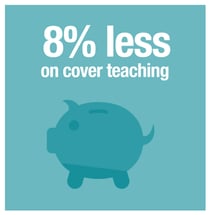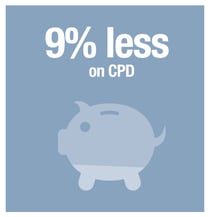According to research from the Teacher Development Trust, the average per pupil spend on CPD in England is £33 per year. But this does not account for teaching cover costs, which I believe, is a critical factor to consider.
I’ve been digging into the DfE’s CFR data, which formed part of the TDT’s analysis. It shows that:
- Maintained schools in England spent £883,22,296 on cover teaching
- This equates to an average per pupil spend of £185 per pupil per year on cover (higher in London)
- This has increased by 1.7% from the previous year (£14.7 million)

Given the funding crisis, this is astonishing. Furthermore, given the ongoing disquiet about the educational impact of supply teachers, it's really important that we better understand such a huge budget line. Even marginal gains will quickly add up.
What’s nearly £900 million actually being spent on?
It’s equally amazing that there appears to be no data available on what the cover teaching was actually used for in English schools. Obviously a large chunk of this is related to sickness cover, but it's hard to establish how much.
 The nearest I can find was a 2013 report from Wales (ESTYN) that sought to break down the expenditure:
The nearest I can find was a 2013 report from Wales (ESTYN) that sought to break down the expenditure:
- They found that 20% of cover teaching was for teachers attending CPD events
- 10% of it was to cover school meetings (did this include lesson observation?)
This data is old, focused purely on Wales and many schools have subsequently shifted their mode of CPD delivery. There has been significant drive to bring professional learning “in-house”. However, bringing CPD “in-house” brings its own costs and potential cover requirements. Middle and senior leaders need to take a much greater role in both the delivery of professional learning and the observation and feedback cycles needed to actually see impact in classrooms.
So, let's halve that estimate to 10% for argument’s sake:
- That would mean an average spend of £18 per pupil on lesson cover for CPD
- Given that the TDT’s data suggests that £33 is the direct cost of CPD per pupil per year, the global figure inclusive of lesson cover is more like £51 per pupil per year
- So an “average” secondary school of 1,000 pupils that thinks it is spending £33,000 per annum on professional development may actually be carrying an additional “hidden” CPD expenditure of £18,000 per annum
How to spend less on CPD
I have compared the spending of schools regularly using IRIS Connect compared to schools not using the system. It paints a fascinating picture and raises some really interesting questions. My analysis found that:
- Schools using IRIS Connect spent 9% less on cover teaching than in the previous year
- Schools using IRIS Connect spent 8% less on CPD than in the previous year
- This equates to an average differential of £12,247 per year compared to other schools


How might we interpret this difference in spending?
I can’t claim causation but given the size of the sample, it’s fair to speculate about the relationship between IRIS Connect and spending. Here are my interpretations. I’d love to hear others too.
Self-efficacy:
The extent to which the teacher feels they are making a difference is strongly related to improved retention, reduced absenteeism and reduced staff turnover. Teachers regularly using IRIS Connect report improved self-efficacy. It is reasonable to deduce that schools who have standardised on IRIS Connect are seeing reductions in their cover teaching budgets as a result.
Reusable video assets:
Once a video has been recorded, it may be reused for multiple purposes. For example, it may be shared with many other teachers as an example of good practice or with another group for feedback. Our most viewed video has been reviewed, on-demand, by over 8,000 other teachers (who've been given permission to view it). How much cover teaching would have been required to achieve this exposure to practice through traditional observation?
Reduced cover for lesson observation:
Traditional lesson observation is grossly inefficient from a time point of view (and from a learning one too, but that's another post). IRIS Connect changes the dynamic. The observation, feedback and professional dialogue processes may be conducted asynchronously, allowing better integration with the timetable and reduced cover requirements. There's a great video of teachers talking about this here >
Reduced cover for CPD sessions and more self-reliant schools:
It stands to reason that schools with IRIS Connect are better able to mobilise their internal skills and expertise and are less reliant on external CPD provision. This data comes from before the launch of our own professional learning programme, which is focused on a curriculum of critical teaching skills and is designed to reduce this reliance even further.
Cultural factors:
School leadership teams who invest in IRIS Connect are also investing in a broader cultural change that recognises the importance of teacher empowerment and trust-based professional learning. This is likely to foster a cultural environment aligned with staff retention and reduced cover costs.
 This opens up many questions...
This opens up many questions...
I’m fascinated by this data and what it means for our community. I’d love to get feedback and a discussion going from school leaders about my workings out and interpretations here. A few initial questions:
- Does this reflect cover teaching spend in your school?
- Where else is CPD spending squirrelled away?
- How are you safeguarding CPD provision in a challenging budgetary environment?
If you’re a senior leader in an IRIS Connect school, join the Leadership Lounge to share your thoughts. Or, feel free to comment below.
Find out how IRIS Connect can transform professional learning at your school >


Leave a comment:
Get blog notifications
Keep up to date with our latest professional learning blogs.